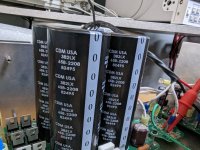Take a look a the rod elliott sound products site. There's lots of great information available there on power supplies and ground lift circuitsGroundlift / groundloop breakers,
Helo Gents,...i'm trying to understand the groundlift scheme. The main idea is clear to me however I see various implementations. I'm using the powersupply example which comnes with the wolverine documentation but I also see different ones where the ground coming from the PSU/amp is connected to 1 AC side of a fullwave bridge and the other to the chassis ground with + and - shorted whereas the powersupply example is connected different.
View attachment 1168524
reg
willem
PSU
True that...I had a look in the beginning a couple of months back and now his articles start to make a lot more sense to me then earlier and I see he is still updating the site so I made a fair donation...Great work!There's lots of great information
w
Hi Andy, what caps are those?
Gaetano.
Is this heatsink oversized for 4 pair version? Im looking for optimal heatsink, to design as slim and small case as possible. I would like to use smaller 10cm width version.

That's a bit harsh.awful
Message them and ask them what the thermal resistance is.Is this heatsink oversized for 4 pair version
A thermal resistance of between 0.18 & 0.20 C/Watt for 80 °C rise is a starting point.
See what they come back with.
Sorry my temper.That's a bit harsh.
Those are decent heatsinks. Not those awful split ones from modushop.
There is a reason if we don't have 400mm long heatsinks but we split them into two 200mm ones. Our supplier would be able to make them but they would be a lot more expensive and in the end we think it was not worth it for our customers. Furthermore, we would need to have them create a special "mold" to produce them which is quite expensive too and in my opinion it's not going to be worth it if the final price is too high for the normal DIY user.
I have had no issues with the split heatsinks or the performance for the wolverine with the outputs balanced between them on the EF3-4be a lot more expensive
Thanks for your feedback. I just wanted to explain why there are no 400mm deep heatsinks available since it's a topic that comes out quite often
Same, these heatsinks work well.I have had no issues with the split heatsinks or the performance for the wolverine with the outputs balanced between them on the EF3-4
Also Modushop/DiyAudio.com shop definitely support their customers. (And the diy community)
And also because they their job is pretty nice!That's a bit harsh.
Gaetano.
Here you goHi Andy, what caps are those?
Gaetano.
Attachments
Hello AndyHi Andy, what caps are those?
Gaetano.
Can I add, what board is that?
Carlos
https://www.diyaudio.com/community/threads/lt4320-based-active-rectifier.336572/Can I add, what board is that?
LT4320 active rectifier, designed by fellow DIYaudio member. I purchased the gerbers from him and have boards on hand if you are interested.
Andy
Do the active rectifiers eliminate the need for snubbing networks on the bridge "diodes" (switches)?
The only statement above I agree with is an active rectifier costs more than conventional bridge rectifiers, the rest I couldn’t disagree more.
You can easily build your own rectifiers for approximately $20 per piece, in the grand scheme of a build this is not a lot of money. They are more beneficial for class A amps, no heat generate from rectifiers, if using a capacitance multiplier psu you gain back approximately 1.5V that the pass transistor drops, no need for snubber components. Definitely not a Snake Oil marketing scam, they work as they should. Also, a soft start module should be used no matter what type of rectification is used. The last point is purely subjective, just listen. Compare silicon rectifier vs active in the same amp with same psu then decided for yourself if it’s worth. I do and use AR for all my builds.
You can easily build your own rectifiers for approximately $20 per piece, in the grand scheme of a build this is not a lot of money. They are more beneficial for class A amps, no heat generate from rectifiers, if using a capacitance multiplier psu you gain back approximately 1.5V that the pass transistor drops, no need for snubber components. Definitely not a Snake Oil marketing scam, they work as they should. Also, a soft start module should be used no matter what type of rectification is used. The last point is purely subjective, just listen. Compare silicon rectifier vs active in the same amp with same psu then decided for yourself if it’s worth. I do and use AR for all my builds.
Hey , Stuart ! .. is the current posted IPS template current ? I'm going to make 2 fully SMD designs and 2 (mini) output stages. Single pair BJT and single pair lateral mosfet (Exicon ECW20N/P20 pair). Just a single pair of the exicon's will nearly match 3 pair BJT (200W). Nice for a subwoofer.
I did want to keep the Wolverine ecosystem in the loop.
PS - 50 X 50mm IPS's.
OS
I did want to keep the Wolverine ecosystem in the loop.
PS - 50 X 50mm IPS's.
OS
- Home
- Amplifiers
- Solid State
- DIY Class A/B Amp The "Wolverine" build thread
